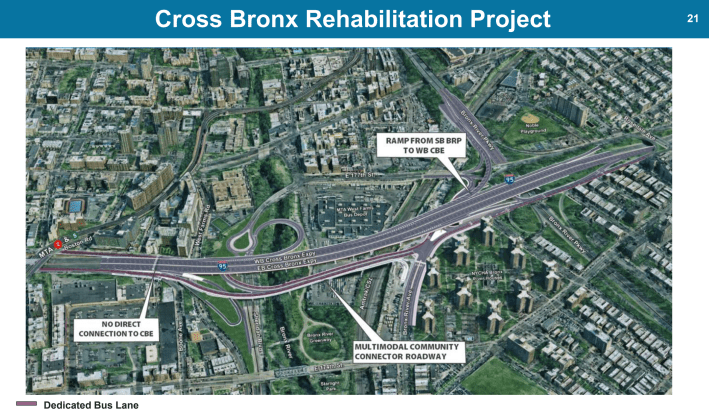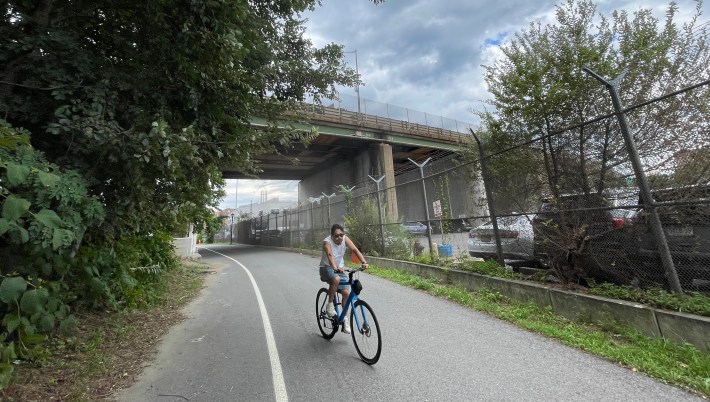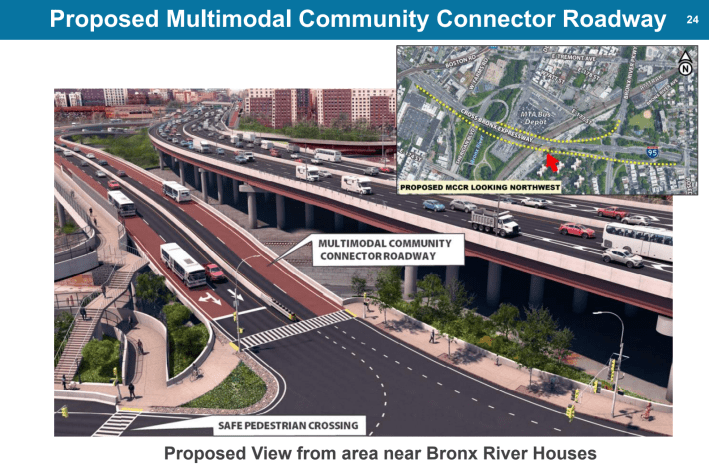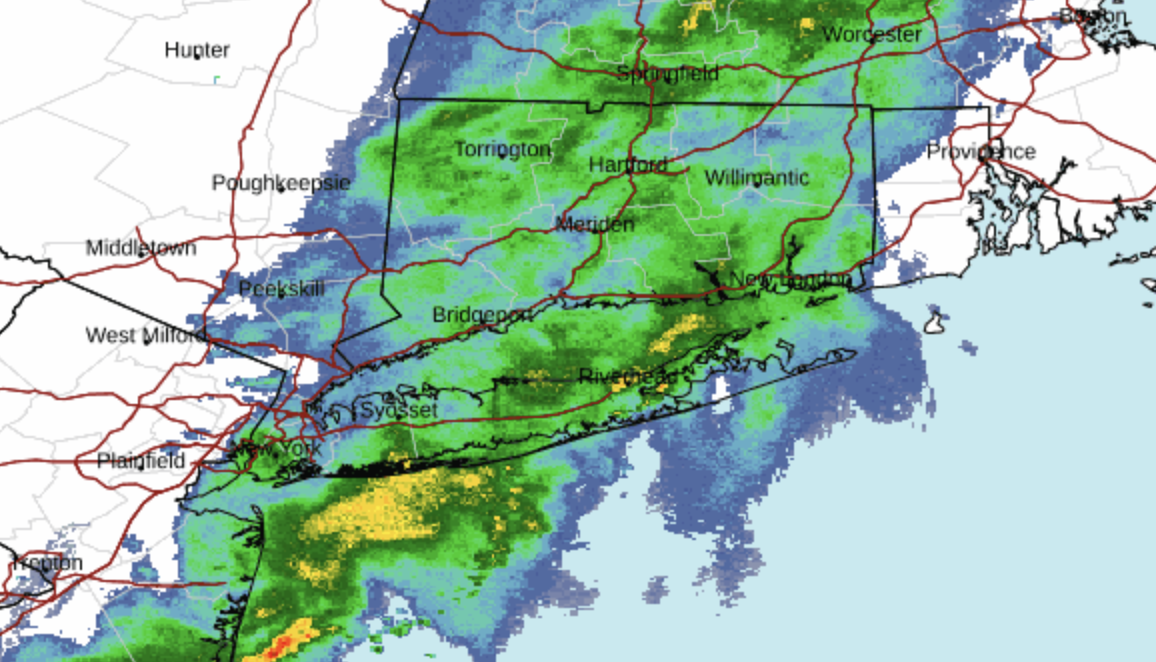More highways in the Bronx? No thonx!
Gov. Hochul plans to use federal money to build a mile-long, four-lane highway alongside the Cross Bronx Expressway — selling it as a "community connector" despite its environmental negatives for neighborhoods long plagued by the deleterious effect of putting cars over people.
Backed by a $150-million U.S. Department of Transportation Mega grant from the Bipartisan Infrastructure Law, a billion-dollar highway reconstruction project in the South Bronx will expand the notorious Cross Bronx Expressway via the addition of a proposed bypass between Boston Road and Rosedale Avenue. The state is selling the proposed bypass, which is as big as a highway and meant to carry highway traffic while the state does repairs on the expressway for four years, as a "multimodal community connector" because diagrams show it with a bike- and bus lane — even though the MTA doesn't currently run any buses on the route.
"This is for drivers," said Nilka Martell, the founder of Loving The Bronx, a community organization devoted to environmental issues in the Boogie Down. "They're pulling the wool over the community's eyes. 'Hey bicyclists, we're going to give you lanes. Hey, pedestrians, hey folks in a wheelchair, look what we're doing.' It's disgusting that they're doing this. At the end of the day, this is not going to be friendly to the environment, and it's going to increase the air and the noise pollution. None of this is going to be beneficial to the community."

The renderings and the text of the federal grant also try to distract from the second highway by suggesting that the enormous new viaduct will have bus lanes that speed Bronxites along on an east-west corridor. Two small problems: 1) At 0.8 miles long, it's not going to help any transit riders get to work because 2) no bus route currently exists that could take advantage of the new lane anyway.
"I don't ever see that not being used by private vehicles," said Martell.
So what's the story?

The alleged multimodal connector's initial role — as a highway bypass during Cross Bronx renovations — will require more space and concrete than any simple local connection would necessitate, saddling the community with an unnecessary highway with a bus lane-to-nowhere.
The state pitches the structure as a community road, but renderings presented to Bronx Community Board 6 earlier this year showed a behemoth that would rise to the same elevation as the adjacent expressway, or 40 to 60 feet above Starlight Park, the West Farms Bus Depot and nearby Amtrak tracks. The ostensible point of the "multimodal connector" is to create a new east-west corridor between Boston Road and Rosedale Avenue, even as anyone looking to make that trip can already do it on nearby E. 174th Street.
The state DOT is building the bypass to divert highway traffic during an $890-million highway reconstruction which the agency says it needs to close a parallel section of the Cross Bronx Expressway to keep traffic from spilling out to local streets. The agency has said that the highway-grade road will remain in place after the repairs are finished and be transitioned to a "community connector." But activists are very dubious.
"If [state DOT] winds up building the bypass and reconstructing the [Cross Bronx], then this 'multimodal connector' is way overbuilt for ... a supposed bike-pedestrian path," said Rachel Weinberger, the director of research and strategy at the Regional Plan Association. "If they build that to the highway weight-bearing standard that they need, that needs to be a very strong piece of infrastructure, trucks are very heavy."

The bypass will also place a second overpass directly over Starlight Park, which is already surrounded by highway ramps. The connector's height requires a steep grade on both the east and west entrances, making it useless for cyclists traveling between Boston Road and Bronx River Avenue. Anyone who would want to actually get to or from the park or the Bronx River Greenway from the "community connector" when the road begins its second act would be zigzagging up and down.
"[State DOT] said to us we heard you wanted a connection to the Greenway, and they said 'We could build a ramp down here,'" said Daniel Ranells, the director of programs and operations at the Bronx River Alliance. "Those ramps would be more concrete and more elevated structures. [And] you've got to go up that elevation. Who's gonna want to use that?"

Adding another east-west connection may sound good on paper, but making the bypass a permanent part of the neighborhood piles one environmental disaster on top of another, Ranells said. A huge slab of unshaded concrete is deathly on a summer day, and it gives rainwater one place to go: into the nearby Bronx River.
"It's another piece of impermeable infrastructure that is going to add to our burden for managing stormwater. There's also no shade on this thing, so it's going to be a hot piece of concrete," he said.
The also project makes a joke of the supposed environmental commitments under the state's landmark emissions-reduction law, the Climate Leadership and Community Protection Act, by building an emissions-boosting road in the middle of a neighborhood already burdened by decades of environmental racism. The environmental advocates at the New York Renews Coalition specifically highlighted that aspect of the project in a recent report.
"The Cross Bronx Expressway project highlights a broader issue with state DOT’s policy of prioritizing highway expansions that increase GHG emissions in some of New York’s most disadvantaged communities, rather than investing in sustainable and equitable transportation solutions that are crafted with meaningful community input," the report said.
How we got here
The Bronx lacks local crosstown connections due to the natural presence of the Bronx River, parks that split roads and the unnatural presence of north-south highways. The lack of east-west connections spanning the borough makes crosstown travel by any form difficult and circuitous, whether you're going by car, bike, bus or on foot.
State DOT long sought to address that problem, and in 2004 proposed a parallel road next to the Cross Bronx known as the Cross Bronx Connector Road System running nearly four miles between University Avenue and the Bruckner Expressway. That proposal includes a stretch being used for the "multimodal connector road."
That proposal sat in a drawer for years. But with the 70-year-old Cross Bronx Expressway reaching the end of its useful life, the state wants to seize the opportunity to saddle the borough with even more highways.
"Here's what's going on: They're coming up against one of the true stupidities of the 1960s, which is they built all this shit next to everything in the city, with no idea what to do when that infrastructure ages out," said Jon Orcutt, a former city transportation official.
In 2018, state DOT released a plan to fix or replace six decrepit elevated sections of the eastern Cross Bronx Expressway. The original plan called for phased lane reductions on sections of the highway, and references the connector road concept; state DOT identified the desire not to "preclude future implementation of the CBE multi-modal Connector Road system" as one of the goals of the effort.
The rehab and repair project was initially supposed to start in early 2019 and finish by the end of 2022. But the work stalled, and now construction isn't supposed to begin until 2026. In the meantime, state DOT took another look at the status of the elevated sections and now claims that the bridges were so degraded that the agency must completely replace, instead of repair, them. That, according to the state DOT, means that sections of the Cross Bronx need to be closed to traffic entirely, though the agency hasn't shared a new analysis showing that in the project's existing documentation.
At the same time, however, the delay gave the state an opportunity to change its plans thanks to money from the Bipartisan Infrastructure Law.
The post-pandemic infrastructure law was supposed to be a once-in-a-generation chance to undo a lot of mistakes of the past, but has become a glorified highway bill all across the country — laying down more sprawl and pollution-generating concrete (even in New York).
In the Bronx, the state DOT used the law to get $150 million from the U.S. DOT to build the so-called "multimodal connector" that won't truly connect communities at all.

In January, Gov. Hochul triumphantly proclaimed the project an "unprecedented commitment" to infrastructure in the Bronx and a break from the policies of Robert Moses — but reading the press release, it's clear that the project is an extremely precedented commitment in the Boogie Down that the harshest critics of New York City's former god-emperor planning boss brought to the borough in the past.
Five paragraphs into the release, after the promise of bike lanes and bus lanes and hosanas about giving the Bronx a new east-west connection, the real truth of the project was revealed: "The multimodal community connector roadway will ... serve a critical role as a temporary diversion/detour road that will negate the need for a long-term closure of one lane in each direction of the Cross Bronx Expressway."
That the state would undertake a gigantic project to fix the elevated sections of the Cross Bronx Expressway is an unfortunate downstream effect of the original construction of the highway in the 1960s. That decision that locked the city and state into having a huge highway run through a densely populated area, which the state now suggests fixing by sprawling the highways out even farther. Fans of ongoing effort to repair the Brooklyn-Queens Expressway's decrepit cantilever in Brooklyn Heights may even recognize the "temporary highway" gambit from when the city proposed replacing the neighborhood's iconic Promenade with a highway during repairs.
"That was a temporary road to carry all the traffic so they could repair the road, and then they were going to dismantle that, and then the traffic was going to go back to the way to where it used to be," said Weinberger. "This the same idea."
That proposal was killed after much outrage in tony Brooklyn Heights. The difference this time is that the state is convinced it can ram this project through the less-politically-powerful South Bronx.
"Calling [it] a 'Community Connector' is not just a misnomer, it's state DOT's pretty deceptive attempt at greenwashing a highway expansion along the Cross Bronx Expressway," said Jaqi Cohen, the director of climate and equity policy at the Tri-State Transportation Campaign. "A similar proposal for the Promenade to divert traffic during the triple cantilever reconstruction on the BQE, but it was nixed after community backlash. If this model is a bad one for Brownstone Brooklyn, then there's no reason state DOT should try it out in the Bronx."
Can this be stopped?
The future of the project is now in the hands of the Federal Highway Administration, which signed off on the initial 2018 proposal — before New York State proposed building a second highway next to the Cross Bronx. The environmental review for the multimodal connector road is in its early stages, and state DOT is sticking to its guns that the new highway will benefits the neighborhood.
"The multimodal connector will provide greater east-west connectivity to the Cross Bronx Expressway corridor, which is currently bisected by the Bronx River and the Amtrak/CSX railroads, and will also reduce traffic congestion and improve air quality for the surrounding community," said state DOT spokesperson Glenn Blain.
But anyone who looks at the project can't help but laugh at the state's insistence that a four-lane highway parallel to the Cross Bronx for almost a mile will somehow fix the lack of crosstown connections.
"They're adamant that this is not a highway expansion, because it is not on the CBE proper," said Martell. "Every time we say that we get 'It's not a highway expansion,' because it's a service road. But it is a highway expansion. No matter how you look at it, it really is."






